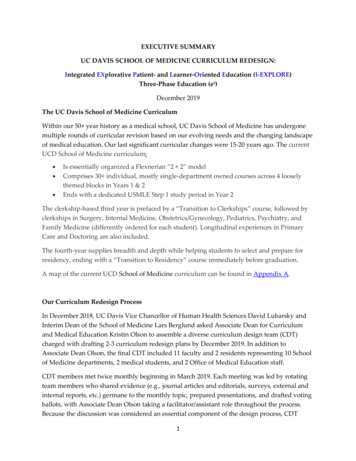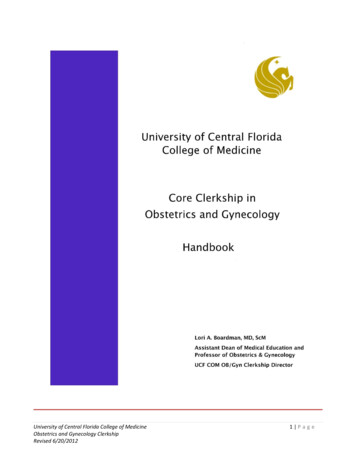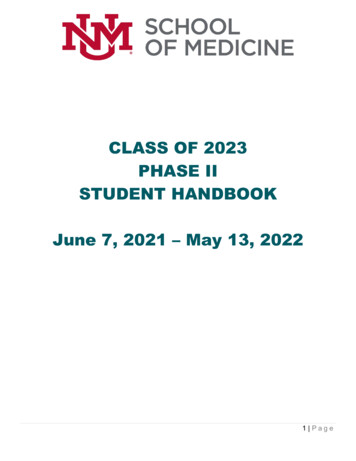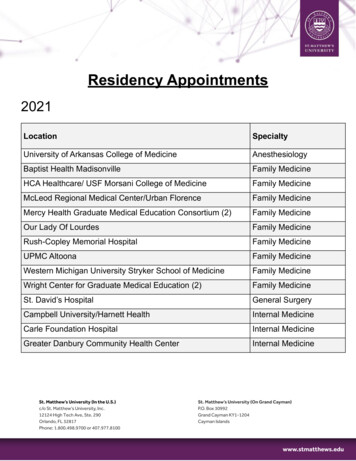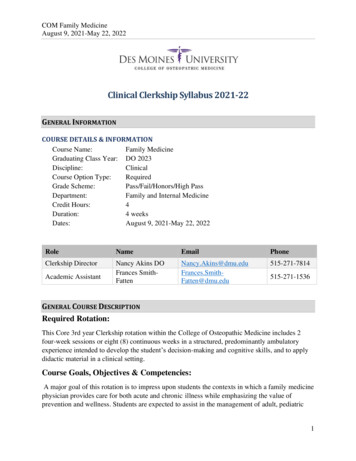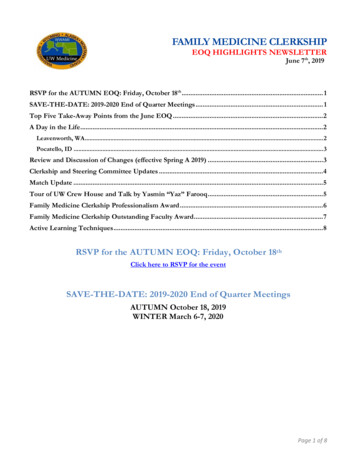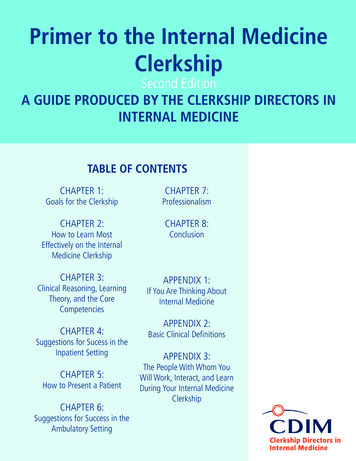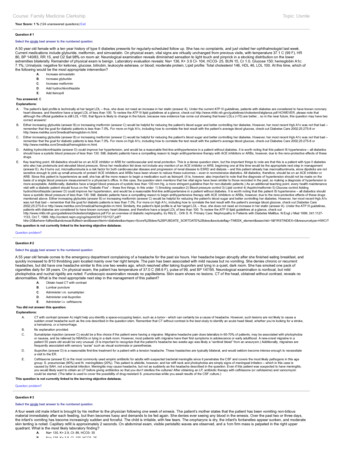
Transcription
Course: Family Medicine ClerkshipTopic: UsmleYour Score: 1 % (124 unanswered questions) ExitQuestion # 1Select the single best answer to the numbered question.A 50 year old female with a ten year history of type II diabetes presents for regularly-scheduled follow up. She has no complaints, and just visited her ophthalmologist last week.Current medications include glyburide, metformin, and simvastatin. On physical exam, vital signs are virtually unchanged from previous visits, with temperature 37.1 C (99 F), HR80, BP 140/83, RR 15, and O2 Sat 98% on room air. Neurological examination reveals diminished sensation to light touch and pinprick in a stocking distribution on the lowerextremities bilaterally. Remainder of physical exam is benign. Laboratory evaluation reveals: Na 136, K 3.9 Cl- 104, HCO3- 25, BUN 15, Cr 1.0, Glucose 150; hemoglobin A1c:7.1%; Urinalysis: negative for ketones, glucose, bilirubin, leukocyte esterase, or blood; moderate protein; Lipid profile: Total cholesterol 146, HDL 46, LDL 100. At this time, which ofthe following would be the most appropriate intervention?A.Increase simvastatinB.Increase glyburideC.D.Increase metforminAdd hydrochlorothiazideE.Add lisinoprilYou answered: EExplanations:A.The patient’s lipid profile is technically at her target LDL – thus, she does not need an increase in her statin (answer A). Under the current ATP III guidelines, patients with diabetes are considered to have known coronaryheart disease, and therefore have a target LDL of less than 100. To review the ATP III lipid guidelines at a glance, check out glance.pdf HOWEVER, please note thatalthough the official guideline is still LDL 100, that figure is likely to change in the future, because new evidence has come out showing that lower LDLs ( 70) are better. so in the near future, this question may have twocorrect answers!B.Either increasing glyburide (answer B) or increasing metformin (answer C) would be helpful for reducing the patient’s blood sugar and better controlling her diabetes. However, her most recent Hgb A1c was not that bad –remember that the goal for diabetic patients is less than 7.0%. For more on Hgb A1c, including how to correlate the test result with the patient’s average blood glucose, check out Diabetes Care 2002;25:275-8 l.C.Either increasing glyburide (answer B) or increasing metformin (answer C) would be helpful for reducing the patient’s blood sugar and better controlling her diabetes. However, her most recent Hgb A1c was not that bad –remember that the goal for diabetic patients is less than 7.0%. For more on Hgb A1c, including how to correlate the test result with the patient’s average blood glucose, check out Diabetes Care 2002;25:275-8 l.D.Adding hydrochlorothiazide (answer D) could improve her hypertension, and would be a reasonable first-line antihypertensive in a patient without diabetes. It is worth noting that this patient IS hypertensive – all diabeticsshould have a systolic blood pressure of less than 130. Still, diabetic patients have a compelling reason to begin antihypertensive therapy with ACE inhibitors or ARBs, however, due to the reno-protective effects of thesedrugs.E.Key teaching point: All diabetics should be on an ACE inhibitor or ARB for cardiovascular and renal protection. This is a dense question stem, but the important things to note are that this is a patient with type II diabeteswho also has proteinuria and elevated blood pressure. Since her medication list does not include any mention of an ACE inhibitor or ARB, beginning one at this time would be the appropriate next step in management(answer E). As it turns out, microalbuminuria is a risk factor for both cardiovascular disease and progression of renal disease to ESRD and dialysis – and this patient already has macroalbuminuria, since dipsticks are notsensitive enough to pick up small amounts of protein! ACE inhibitors and ARBs have been shown to reduce these outcomes – even in normotensive diabetics. All diabetics, therefore, should be on an ACE inhibitor orARB. Since this patient is hypertensive as well, she has all the more reason to begin a medication such as lisinopril. (It is, however, also important to note that the diagnosis of hypertension should not be made on thebasis of a single blood pressure measurement in a physician’s office. In this case, the question stem mentions that her vital signs have been similar to those recorded in the past, so making a diagnosis of hypertension ismore acceptable. Additionally, diabetics have a target blood pressure of systolic less than 130 mm Hg, a more stringent guideline than for non-diabetic patients.) As an additional teaching point, every health maintenancevisit with a diabetic patient should focus on the “Diabetic Five” – these five things, in this order: 1) Smoking cessation 2) Blood pressure control 3) Lipid control 4) Aspirin/metformin 5) Glucose control Addinghydrochlorothiazide (answer D) could improve her hypertension, and would be a reasonable first-line antihypertensive in a patient without diabetes. It is worth noting that this patient IS hypertensive – all diabetics shouldhave a systolic blood pressure of less than 130. Still, diabetic patients have a compelling reason to begin antihypertensive therapy with ACE inhibitors or ARBs, however, due to the reno-protective effects of these drugsmentioned above. Either increasing glyburide (answer B) or increasing metformin (answer C) would be helpful for reducing the patient’s blood sugar and better controlling her diabetes. However, her most recent Hgb A1cwas not that bad – remember that the goal for diabetic patients is less than 7.0%. For more on Hgb A1c, including how to correlate the test result with the patient’s average blood glucose, check out Diabetes Care2002;25:275-8 or http://www.metrika.com/3medical/hemoglobin-m.html. Similarly, the patient’s lipid profile is at her target LDL – thus, she does not need an increase in her statin (answer A). Under the ATP III guidelines,patients with diabetes are considered to have known coronary heart disease, and therefore have a target LDL of less than 100. To review the ATP III lipid guidelines at a glance, check /atglance.pdf For an overview of diabetic nephropathy, try Ritz E., Orth S. R. Primary Care: Nephropathy in Patients with Diabetes Mellitus. N Engl J Med 1999; 341:11271133, Oct 7, 1999. f?hits 20&where fulltext&andorexactfulltext and&searchterm diabetes&sortspec Score%2Bdesc%2BPUBDATE SORTDATE%2Bdesc&excludeflag TWEEK element&searchid 1&FIRSTINDEX 0&resourcetype HWCITThis question is not currently linked to the learning objective database.Question problem?Question # 2Select the single best answer to the numbered question.A 55 year old female comes to the emergency department complaining of a headache for the past six hours. Her headache began abruptly after she finished eating breakfast, andquickly increased to 8/10 throbbing pain located mainly over her right temple. The pain has been associated with mild nausea but no vomiting. She denies chronic or recurrentheadaches, but did have one headache similar to this one two weeks ago, which resolved after taking ibuprofen and lying in a quiet, dark room. She has smoked one pack ofcigarettes daily for 38 years. On physical exam, the patient has temperature of 37.0 C (98.6 F), pulse of 99, and BP 147/95. Neurological examination is nonfocal, but mildphotophobia and nuchal rigidity are noted. Fundoscopic examination reveals no papilledema. Skin exam shows no lesions. CT of the head, obtained without contrast, reveals noabnormalities. What is the most appropriate next step in the management of this patient?A.B.Obtain head CT with contrastLumbar punctureC.D.E.Administer i.m. sumatriptanAdminister oral ibuprofenAdminister i.v. ceftriaxoneYou did not answer this question.Explanations:A.CT with contrast (answer A) might help you identify a space-occupying lesion, such as a tumor - which can certainly be a cause of headache. However, such lesions are not likely to cause asudden onset headache such as the one described in the question stem. Remember that CT without contrast is the best study to identify an acute head bleed, whether you’re looking for a stroke,a hematoma, or a hemorrhage.B.No explanation provided.C.Sumatriptan injection (answer C) would be a fine choice if the patient were having a migraine. Migraine headache pain does lateralize in 60-70% of patients, may be associated with photophobiaor nausea, and be relieved by NSAIDs or lying in a dark room. However, most patients with migraine have their first symptoms in adolescence or early adulthood. A new-onset migraine in apatient 55 years old would be very unusual. (It is important to recognize that the patient’s headache two weeks ago was likely a “sentinel bleed” from an aneurysm.) Additionally, migraines arefrequently associated with sensory “auras” such as visual scotomata or paresthesias.D.Ibuprofen (answer D) is a reasonable first-line treatment for a patient with a tension headache. These headaches are typically bilateral, and would seldom become intense enough to necessitatea visit to the ER.E.Ceftriaxone (answer E) is the most commonly used empiric antibiotic for adults with suspected bacterial meningitis since it penetrates the CSF and covers the most likely pathogens in this agegroup: S. pneumoniae (60%) and N. meningitides (20%). This patient is afebrile, however, and her stiff neck and photophobia are simply signs of meningeal irritation – which in this case iscaused by SAH, not a bacterial infection. Meningitis may cause headache, but not as suddenly as the headache described in the question. Even if this patient was suspected to have meningitis,you would likely want to obtain an LP before giving antibiotics so that you don’t sterilize the cultures! After obtaining an LP, antibiotic therapy with ceftriaxone (or cefotaxime) and vancomycincould be started. (The latter is used to cover the possibility of drug-resistant S. pneumoniae while you await results of the CSF culture.)This question is not currently linked to the learning objective database.Question problem?Question # 3Select the single best answer to the numbered question.A four week old male infant is brought by his mother to the physician following one week of emesis. The patient’s mother states that the patient has been vomiting non-biliousmaterial immediately after each feeding, but then becomes fussy and demands to be fed again. She denies ever seeing any blood in the emesis. Over the past two or three days,the infant’s vomiting has become increasingly sudden and forceful. The child is irritable, with few tears. The oropharynx is dry, the infant’s fontanelles appear sunken, and moderateskin tenting is noted. Capillary refill is approximately 2 seconds. On abdominal exam, visible peristaltic waves are observed, and a 1cm firm mass is palpated in the right upperquadrant. What is the most likely laboratory finding?A.Na 130, K 2.9, Cl- 89, HCO3- 35B.Na 138, K 3.8, Cl- 100, HCO3- 26
B.Na 138, K 3.8, Cl- 100, HCO3- 26C.Na 150, K 4.0, Cl- 100, HCO3- 24D.E.Na 140, K 3.8, Cl- 100, HCO3- 15Na 130, K 5.8, Cl- 110, HCO3- 20You did not answer this question.Explanations:A.Key teaching point #1: When you see a 3-6 week old infant with projectile vomiting, and an olive-like mass on physical exam, think pyloric stenosis! Key teaching point #2: Losing HCl in emesisleads to a hypochloremic, hypokalemic metabolic alkalosis. This vignette describes a classic presentation of pyloric stenosis, a commonly-tested disorder for which the associated electrolyteabnormality is a hypochloremic, hypokalemic metabolic alkalosis (answer A). Even without recognizing that this is a case of pyloric stenosis, you should be able to think through the question andarrive at the correct answer. Think about what is going on with this patient. Repetitive vomiting of acidic gastric juices causes the loss of HCl – thus, the patient’s Cl- should be low. Since you’relosing H , there will also be a metabolic alkalosis, so the HCO3- will be elevated as well. Finally, in order to maintain pH balance, the kidneys avidly reabsorb H , but they can only do this at theexpense of K , resulting in hypokalemia. (Review Dr. Barrett’s diagrams of the principal and intercalated cells of the cortical collecting duct from her second year “Diuretics” lecture to remindyourself of how this happens physiologically. s.cfm?CID 1) Thinking about things this way, you’re looking for the answer that shows adecrease in Cl- and K , and an increase in HCO3- (answer A). As previously mentioned, the question stem describes a truly classic case of pyloric stenosis, which is important to recognize. Keyfeatures include: 1) palpable abdominal mass – often described as an “olive” (Sometimes, the olive is only palpable after feedings, so doing a test feeding in clinic can confirm the diagnosis.); 2)projectile vomiting; 3) vomiting immediately after feeding, then demanding to be refed - “hungry vomiters”; 4) presentation at age 3-6 weeks. The initial test of choice when the diagnosis isunclear is abdominal ultrasound, which will reveal the hypertrophied pylorus. (Barium studies may also be used, but these have the undesirable side effect of exposing an infant to radiation.) Thetreatment of pyloric stenosis is, of course, surgical – the patient needs a pyloromyotomy. Answer B represents essentially normal lab values, which this child would not be expected todemonstrate given his dehydration and one week history of vomiting. The primary abnormality in answer C is hypernatremia. This situation results when a patient has hypotonic fluid loss, orloses more water than they do sodium – as can happen in patients with dehydration with inadequate free water intake. It is important to realize that this patient is not losing hypotonic fluids,however – he is losing large amounts of electrolytes with each episode of vomiting. The primary abnormality in Answer D is a low bicarbonate – which, in this situation, represents an anion gapmetabolic acidosis. Remember that Anion gap sodium – chloride – bicarbonate 12 /- 4 The anion gap in this question stem would be 140 – 100 – 16 24, which is elevated. Possibleetiologies of an anion gap metabolic acidosis include the things on the MUDPILES mnemonic – none of which would apply to this patient. For an eMedicine article on metabolic acidosis(including the MUDPILES mnemonic) check out: http://www.emedicine.com/ped/topic15.htm Answer E represents a patient with hyponatremia and hyperkalemia. This situation could arise inadrenal insufficiency due to insufficient aldosterone.B.Answer B represents essentially normal lab values, which this child would not be expected to demonstrate given his dehydration and one week history of vomiting.C.The primary abnormality in answer C is hypernatremia. This situation results when a patient has hypotonic fluid loss, or loses more water than they do sodium – as can happen in patients withdehydration with inadequate free water intake. It is important to realize that this patient is not losing hypotonic fluids, however – he is losing large amounts of electrolytes with each episode ofvomiting.D.The primary abnormality in Answer D is a low bicarbonate – which, in this situation, represents an anion gap metabolic acidosis. Remember that Anion gap sodium – chloride – bicarbonate 12 /- 4 The anion gap in this question stem would be 140 – 100 – 16 24, which is elevated. Possible etiologies of an anion gap metabolic acidosis include the things on the MUDPILESmnemonic – none of which would apply to this patient. For an eMedicine article on metabolic acidosis (including the MUDPILES mnemonic) check out: http://www.emedicine.com/ped/topic15.htmE.Answer E represents a patient with hyponatremia and hyperkalemia. This situation could arise in adrenal insufficiency due to insufficient aldosterone.This question is not currently linked to the learning objective database.Question problem?Question # 4Select the single best answer to the numbered question.A 30 year old female presents to her physician with a breast mass. She first noted a small “lump” in her left breast while showering about six weeks ago. She has noted no changein the size of the mass since that time, and she denies pain or nipple discharge. Family history is significant for a paternal grandmother who had breast cancer at age 79. Physicalexamination reveals a soft, round, mobile 1cm mass in the lower outer quadrant of the left breast. No skin changes are noted. What is the most appropriate next step in themanagement of this patient?A.B.C.D.E.MammographyRefer the patient for radical mastectomyBegin levonorgestrel/etinyl estradiolGenetic testing for BRCA1 and BRCA2Ultrasound of breast massYou did not answer this question.Explanations:A.Mammograms are not the best diagnostic study in a woman under 35 years old due to the density of breast tissue.B.Answer B might be an appropriate treatment for some breast cancers. But to make a diagnosis of cancer requires tissue, so referral for mastectomy would certainly not be appropriate at thistime.C.Many oral contraceptive pills (OCPs) contain combinations of levonorgestrel and ethinyl estradiol (answer C). There are some non-contraceptive indications for prescribing OCPs, such asdysmenorrhea or endometriosis, and some practicioners do prescribe OCPs to help reduce the pain caused by hormonal fluctuations of benign breast cysts. This patient does not complain ofpain, however, and more importantly, you do not yet know what her breast mass is. While not all breast masses are pathological, they all demand an explanation. Since this patient is less than35, she needs ultrasound.D.Genetic testing for BRCA1 and BRCA2 (answer D) might be an appropriate step for an asymptomatic woman with a strong family history of breast cancer, or to evaluate ovarian cancer risk in apatient with proven breast cancer. There are two reasons why this response is incorrect for this question, however. First, this patient’s family history of breast cancer is not terribly impressive.Breast cancer is so common that 12% of all women will have a positive family history. To identify patients at risk for BRCA1 and BRCA2 mutations, look for patients with multiple first-degreerelatives (mothers, daughters, or sisters) who had breast or ovarian cancer at young ages (less than 40-50). In general, the USMLE tests the most classic presentation of any disease – for thecorrect answer to be BRCA1/BRCA2 testing, the question stem would have to give you more than just one relative who had breast cancer at age 79. Second, and more important, even if thispatient had a family history that was suggestive for a BRCA1 or BRCA2 mutation, her problem right now is a breast mass that needs to be evaluated with imaging and potentially a biopsy.Genetic testing might help you assess the patient’s lifetime breast cancer risk, but it will not help you determine if this particular breast mass is something bad or not.E.Key teaching point: Mammogram is the preferred imaging study for women over 35, while women younger than 35 should get ultrasound to evaluate a breast mass. In women younger than 35,the breast tissue is often too dense to evaluate mammographically, and the incidence of breast cancer younger women is still very low. Studies have shown that routine mammography is notcost-effective nor clinically beneficial for younger women unless there is a high suspicion of cancer by clinical examination. The clinical characteristics of this mass are non-suspicious formalignancy, though. Features commonly associated with malignancy include hard, irregularly-shaped, immobile masses 2cm in size. Since this patient’s mass is soft, small, rounded, andmobile, it is likely to be a benign fibroadenoma. Thus, the patient should receive ultrasound, and the correct answer is E. If the patient were over 35, she should get a diagnostic mammogram(answer A). Questions about the workup of a breast mass are common on the USMLE, so it is worth thinking about how the workup would proceed in this patient. If ultrasound were obtained andthe mass is found to be cystic in nature, it is very unlikely to be malignant, and no further evaluation is necessary (although the cyst may be aspirated if it is causing the patient pain). If it is solid,however, tissue will be required to make a definitive diagnosis, and the patient should receive a biopsy. Since breast tissue may undergo changes related to the menstrual cycle, many clinicianswill simply ask a young patient with a breast mass to return 3-10 days following her next menstrual cycle to re-evaluate the lump. Answer B might be an appropriate treatment for some breastcancers. But to make a diagnosis of cancer requires tissue, so referral for mastectomy would certainly not be appropriate at this time. Many oral contraceptive pills (OCPs) contain combinationsof levonorgestrel and ethinyl estradiol (answer C). There are some non-contraceptive indications for prescribing OCPs, such as dysmenorrhea or endometriosis, and some practicioners doprescribe OCPs to help reduce the pain caused by hormonal fluctuations of benign breast cysts. This patient does not complain of pain, however, and more importantly, you do not yet know whather breast mass is. While not all breast masses are pathological, they all demand an explanation. Since this patient is less than 35, she needs ultrasound. Genetic testing for BRCA1 and BRCA2(answer D) might be an appropriate step for an asymptomatic woman with a strong family history of breast cancer, or to evaluate ovarian cancer risk in a patient with proven breast cancer. Thereare two reasons why this response is incorrect for this question, however. First, this patient’s family history of breast cancer is not terribly impressive. Breast cancer is so common that 12% of allwomen will have a positive family history. To identify patients at risk for BRCA1 and BRCA2 mutations, look for patients with multiple first-degree relatives (mothers, daughters, or sisters) whohad breast or ovarian cancer at young ages (less than 40-50). In general, the USMLE tests the most classic presentation of any disease – for the correct answer to be BRCA1/BRCA2 testing, thequestion stem would have to give you more than just one relative who had breast cancer at age 79. Second, and more important, even if this patient had a family history that was suggestive for aBRCA1 or BRCA2 mutation, her problem right now is a breast mass that needs to be evaluated with imaging and potentially a biopsy. Genetic testing might help you assess the patient’s lifetimebreast cancer risk, but it will not help you determine if this particular breast mass is something bad or not.This question is not currently linked to the learning objective database.Question problem?Question # 5Select the single best answer to the numbered question.An otherwise healthy 8 year old girl presents with two weeks of perianal pruritis. She has two younger brothers, one of whom has had similar complaints for the past few days.Physical exam reveals perianal erythema with mild excoriations. The “scotch tape test” reveals several bean-shaped white eggs. What is the most likely diagnosis in this patient?A.B.TrichuriasisEnterobiasisC.D.E.Child abuseFecal soilageAtopic dermatitisYou did not answer this question.Explanations:A.Whipworm or trichuriasis (choice A) is a common intestinal helminthic infection worldwide, with the highest prevalence in tropical regions. Hosts are usually asymptomatic, though the disease can
A.Whipworm or trichuriasis (choice A) is a common intestinal helminthic infection worldwide, with the highest prevalence in tropical regions. Hosts are usually asymptomatic, though the disease cancause loose stools that contain mucus or blood, resulting in a secondary anemia. Trichuriasis is also classically associated with rectal prolapse in a patient with a heavy parasite load. Heavyloads can affect a child’s growth and cognition. Diagnosis is made by stool examination for eggs, which are barrel shaped with a hyaline plug at each end.B.This is a classic case of enterobiasis (answer B) or “pinworm.” The most common presenting symptom is intense anal itching or pruritus ani. Other symptoms (such as abdominal pain/fullness ornausea and vomiting) may occur if the worm burden is high. Girls may also present with a vulvovaginitis or urinary tract infection if the worms migrate. Eosinophilic enterocolitis and appendicitisare rarer complications. Some teaching points: 1) The first line treatment of enterobiasis is either mebendazole or albendazole - one dose is usually sufficient, but a second dose 1-2 weeks latercan help prevent reinfection. Pyrantel pamoate is second line because of its side effects (nausea, vomiting, abdominal cramping, neurotoxicity, and elevated LFTs). However, pyrantel pamoate isfirst line if the patient is pregnant, since mebendazole and albendazole are teratogenic. 2) Enterobiasis is spready by a fecal-oral route and usually presents in kids ages 5-10 years old. It is veryuncommon in children less than 2 years old. 3) The “scotch tape” test is the best way to confirm the diagnosis. It involves covering a wooden stick with scotch tape with the sticky side facingoutward, and then pressing the tape against the perianal skin. Bean-shaped eggs stick to the tape which can then be visualized under a microscope. Sometimes whole adult worms can be foundperianally - they are white, pin-shaped and can be up to 13 mm long. 4) Treatment should include simultaneous treatment of all household members to prevent reinfection. Bedding and clothingshould be washed, fingernails should be clipped (since this is the most common place for eggs to hide out), and hygienic measures increased (handwashing and bathing). Whipworm ortrichuriasis (choice A) is a common intestinal helminthic infection worldwide, with the highest prevalence in tropical regions. Hosts are usually asymptomatic, though the disease can cause loosestools that contain mucus or blood, resulting in a secondary anemia. Trichuriasis is also classically associated with rectal prolapse in a patient with a heavy parasite load. Heavy loads can affecta child’s growth and cognition. Diagnosis is made by stool examination for eggs, which are barrel shaped with a hyaline plug at each end. Child abuse (choice C) is not the best answer, though itisn’t unreasonable to have this on your differential when children present with genital or anal complaints. In this case, we have a clear, identifiable cause of the perianal itching. Fecal soilage(choice D) is part of the differential of anal pruritis and can be due to any cause of diarrhea or loose stools. Some patients have an abnormality with internal anal sphincter relaxation. When analitching is otherwise unexplained, this diagnosis should be entertained. Eczema or atopic dermatitis (choice E) is certainly part of the differential diagnosis of anal pruritis, though just the historydoes suggest an infectious cause. This familial allergic reaction is often associated with asthma and allergic rhinitis. The rash of eczema is intensely pruritic, and usually appears as erythematouspatches with scaling. In children, eczema usually occurs on the face, scalp, extremities, diaper area and trunk, and usually presents by age 7.C.Child abuse (choice C) is not the best answer, though it isn’t unreasonable to have this on your differential when children present with genital or anal complaints. In this case, we have a clear,identifiable cause of the perianal itching.D.Fecal soilage (choice D) is part of the differential of anal pruritis and can be due to any cause of diarrhea or loose stools. Some patients have an abnormality with internal anal sphincterrelaxation. When anal itching is otherwise unexplained, this diagnosis should be entertained.E.Eczema or atopic dermatitis (choice E) is certainly part of the differential diagnosis of anal pruritis, though just the history does suggest an infectious cause. This familial allergic reaction is oftenassociated with asthma and allergic rhinitis. The rash of eczema is intensely pruritic, and usually appears as erythematous patches with scaling. In children, eczema usually occurs on the face,scalp, extremities, diaper area and trunk, and usually presents by age 7.This question is not currently linked to the learning objective database.Question problem?Question # 6Select the single best answer to the numbered question.A 66 year old male presents to the emergency department with chest pain. The pain began two hours ago as the patient was watching television. The pain is described as"squeezing" and is located primarily substernally with radiation to the jaw. Past medical history includes diabetes mellitus, hypertension, hyperlipidemia, and a 50 pack/year smokinghabit. On physical exam, the patient appears anxious and diaphoretic. The patient is given supplemental oxygen by nasal cannula, and aspirin, morphine, and nitroglycerin areadministered. EKG obtained on presentation to the ED is shown. Of the following, which is the most appropriate study to obtain next?
A.AortogramB.Troponin IC.Stress echoD.Exercise stress testE.CT angiogram of chestYou did not answer this question.Explanations:A.An aortogram (answer A) used to be the gold standard for the diagnosis of an aortic aneurysm. Now, less-invasive imaging modalities such as CT, MRI, and echo have largely supplantedaortograms for the diagnosis of aortic dissection. In any case, while aortic dissection ought to be considered in patients with chest pain, this patient’s history is strongly suggestiv
Course: Family Medicine Clerkship Topic: Usmle Your Score: 1 % (124 unanswered questions) Exit Question # 1 Select the single best answer to the numbered question. A 50 year old female with a ten year history of type II diabetes presents for regularly-scheduled follow up. She has no complaints, and just visited her ophthalmologist last week.
